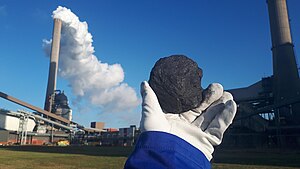
This AAEA article claims how communities located within a certain radius of coal powered plants' smokestacks are susceptible to harmful effects of flyash particles and other harmful emissions. The majority of these communities have a high African American population compared to whites and other ethnicities. These primarily African communities are in areas of poor air quality and have high rates of air pollution related illnesses.
Coal Powered-Plant Pollution Effect on African American Communities[edit | edit source]
The study concludes that thirty miles is the distance within which people experience the maximum effects of smokestack emissions. AAEA doubts this statistic is true for NOx and SOx. Nitrates and sulfates travel long distances to damage health and environment depending on atmospheric conditions. There is no reference for this citation and it is not needed to document disproportionate impact. Cumulative and comprehensive sources, particularly mobile sources, of air pollution cause disproportionate impacts in African American communities.
Distance Related to Effects[edit | edit source]
The Atlanta-based Georgia Coalition for the People's Agenda and Washington[1]- based Black Leadership Forum,[2] released the study showing that 68 percent of blacks lived within 30 miles of a coal-fired power plant, compared with 56 percent of U.S. whites. Nationwide, 71 percent of blacks live in counties that don't meet federal air pollution standards, compared with 58 percent of whites, the study said. The report correlates respiratory illnesses in Washington, DC to 5 power plants here. Two of those plants are oil-fired turbine peaking plants.
Health Concerns[edit | edit source]
According to the study, U.S. coal fueled power plants account for 67 percent of all emissions of sulfur dioxide. Emissions from power plants also combine with other pollutants to form ozone, a principle component of smog, which can cause a number of respiratory ailments. The report states that African Americans account for 17% of the people living within 5 miles of a power plant flyash waste site. Again, there is no reference for this statistic and it is not needed to prove disproportionate air pollution impacts.
The study reported that asthma hospitalization rates for blacks, at 35.6 admissions per 10,000 people, were three times the white hospitalization rate of 10.6 admissions per 10,000 people. The death rate from asthma among blacks of 38.7 deaths per 1 million people was twice that for whites, which was 14.2 deaths per million. [3]